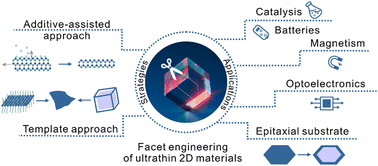Facet engineering of ultrathin two-dimensional materials
Abstract
Ultrathin two-dimensional (2D) materials exhibit broad application prospects in many fields due to the enhanced specific surface area to volume ratio and quantum confinement effect. Because of the atomic thickness and various orientations, ultrathin 2D materials exposing specific facets have drawn great attention for various applications in catalysis, batteries, optoelectronics, magnetism, epitaxial template for material growth, etc. Though maintaining the atomic thickness of 2D materials while controlling crystal facets is an enormous challenge, breakthroughs are being made. This review provides a comprehensive overview of the recent advances in the facet engineering of 2D materials, ranging from a basic understanding of facets and the corresponding approaches and the significance of facet engineering. We also propose current challenges and forecast future development directions including the establishment of a facet database, the fabrication of new 2D materials, the design of specific substrates, and the introduction of theoretical calculations and in situ characterization techniques. This review can guide researchers to design ultrathin 2D materials with unique and distinct facets and provide an insight into the applications of energy, magnetism, optics, biomedicine, and other fields.



 Please wait while we load your content...
Please wait while we load your content...